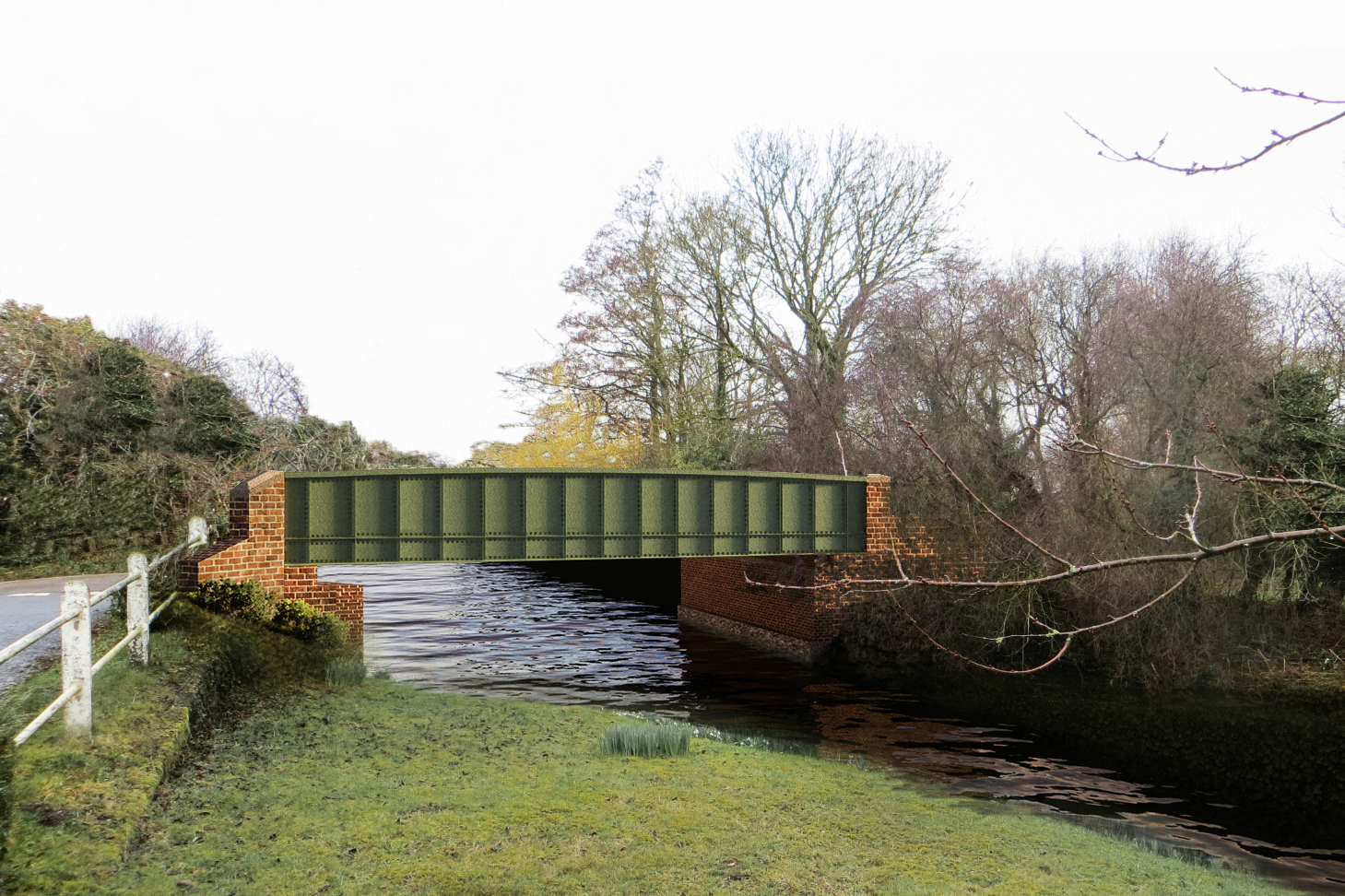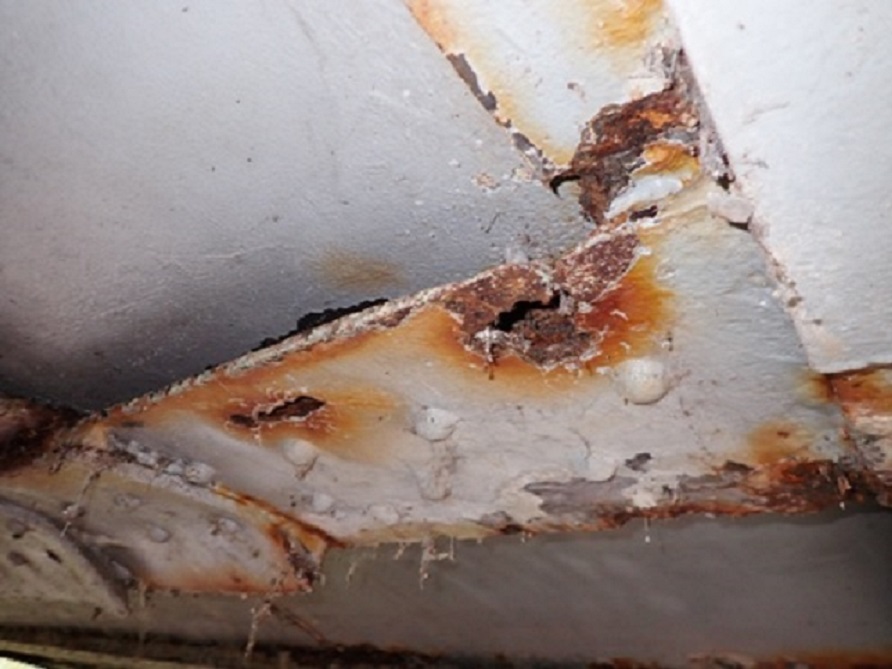Boxted Bridge, Wick Road, Boxted, Colchester

Works location and photos
The current position
Boxted Bridge (ECC No. 0059) was built in 1897 and is located on Wick Road/Lower Farm Road near the junction of Sky Hall Hill in Boxted on the Essex/Suffolk border where it crosses the River Stour. The bridge currently carries two way traffic.
In 2018 a Principal Inspection identified that the bridge was displaying signs of distress including corrosion, delamination, deformation and cracking. The bridge is nearing the end of its natural lifespan.
The possibility of repairing the current structure was explored during an Option Study which has determined that the structural form of the bridge, as well as its current condition are prohibitive factors to undertaking effective structural repairs without replacing the structure as a whole. The Option Study outlines other measures considered for managing the crossing point, as well as identifying possible improvements to resolve the existing road alignment and visibility constraints at the junction. Further details are explained in our Questions and Answers in the Document section below.
Our preferred option (Option 7B) is to replace the existing structure on a slightly widened footprint to allow for the safe movement of fire engine vehicles at the junction. Our studies indicate that vehicles, such as a refuse vehicles and fire engines cannot safely manoeuvre at the junction, and has contributed to a number of vehicle strikes at the bridge and to nearby private property.
 Latest computer generated artist impression of proposed bridge.
Latest computer generated artist impression of proposed bridge.
We anticipate the design of a future bridge would be visually similar to the current bridge and sympathetic to the area, recognising that this is in an Area of Outstanding Natural Beauty as illustrated by the computer generated artist impression.
Please refer to the Document section below to view our proposed bridge design which will be submitted through the formal Essex County Council planning process in November 2021.
Investigation works have supported new bridge design
Ground investigations and trial holes works were completed during November 2020. These works were successfully carried out with the support of archaeological supervision and advice of external specialists including geotechnical consultants and building surveyors prior to commencing works.
The results of the ground surveys have informed our proposed design and foundations options for a replacement bridge. They have supported structural considerations for the proposed option and helped us understand possible improvements to resolve the existing road alignment and visibility constraints at the junction.
We do envisage that a new bridge design will look visually similar to the existing bridge as can be seen in in the computer-generated artist impression above, and our proposed design.
The bridge is in an Area of Outstanding Natural Beauty (AONB) and as such we have designed a replacement bridge to be as similar as possible to the existing bridge with as minimal change as possible to the aesthetics of the area.
Load testing - September 2025
Our specialist supply chain partner completed load testing on Boxted Bridge on Wednesday 10 September 2025.
They will provide a full report in due course, which will be evaluated by Essex Highways engineers.
Investigations into installing a temporary footbridge - October 2024
Essex Highways is currently exploring provisional options to install a temporary footbridge to allow pedestrians and dismounted cyclists to pass over the river while Boxted Bridge remains closed due to safety concerns.
A preliminary design for a temporary structure is being developed, which will provide information to allow Essex Highways engineers to assess its feasibility.
In the meantime, we would like to remind you that additional information regarding the existing structure is available in the current planning application, which was uploaded to the Essex County Council and Babergh District Council planning permission portals in September.
For details of the consultation expiry date, please refer to the portals.
Link to ECC website: https://planning.essex.gov.uk.
Essex County Council application ref: CC/COL/106/21
Link to Babergh DC website: https://www.babergh.gov.uk/planning
Babergh District Council application ref: DC/22/00050.
We will continue to share key updates with the community as they become available.
Emergency closure introduced 30 June 2023 following bridge inspection
 Evidence of heavy corrosion and missing rivets in steel structure
Evidence of heavy corrosion and missing rivets in steel structure
An inspection of Boxted Bridge has raised new concerns regarding the bridge’s deteriorating condition and loading capacity. In light of this latest information we have taken the decision to implement an emergency road closure preventing vehicles from using the structure. The closure of the bridge, which is situated on Wick Road at the junction with Lower Farm Road and Sky Hall Hill in Boxted, will take immediate effect while highway engineers assess the situation and consider next steps.
The bridge will be fully closed to all vehicles and pedestrians while our investigations continue, with no access permitted to pass through the closed section of the road until further notice.
We fully appreciate that this road closure will be inconvenient to those who regularly use the route however as a responsible highways authority we must put public safety first while our investigations continue.
Alternative routes are available via:
1. Thorington Street, Lower Street, Higham Road, Stratford Road, Ipswich Road, Low Lift Cottage Road, Docuras Farm Road, Water Lane and vice versa (with access only into Church Street, Sky Hall Hill and Wick Road).
2. Skye Hall Hill, Dedham Road, Cooks Hill, Parsonage Hill, Church Road, Burnt Dick Hill, Park Road, Horkesley Hill, Bear Street, Birch Street, Stoke Road, Nayland Road, Church Street, Park Street, Park Road and vice versa (with access only into Church Street, Sky Hall Hill and Wick Road).
Please take additional care when travelling through the area, observing road signs in place.
Further updates will be shared as soon as details become available.
Further information
It is our intention to keep the community informed as the project develops. The latest information will be shared on this webpage.
Additional information is included in the Document section below, including the latest Questions and Answers.
Should you have a question directly related to Boxted Bridge which has not already been answered on this page you may wish to contact the project team directly by email: boxtedenquiries@essexhighways.org.